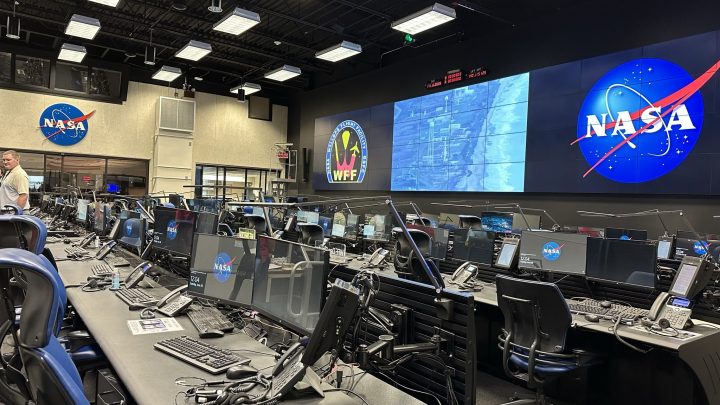
It may not have a cantina, but this Virginia spaceport is firing up its local economy
It may not have a cantina, but this Virginia spaceport is firing up its local economy

Last year, the world set a Space Age record by launching more than 180 rockets into orbit, and there were scores of launches to suborbital altitudes. The spaceports where those launches are taking place don’t quite have the gritty ambience of the “wretched hive of scum and villainy” that was Mos Eisley in the original “Star Wars,” but they are starting to see more and more of their local economies tied to the rapidly growing space industry.
One town experiencing that growth is Chincoteague, Virginia, located in perfect viewing distance of NASA’s Wallops Flight Facility. The flight facility is the country’s oldest rocket range in continuous use. The military had its first launch from here in 1945, before NASA even existed, and more than 16,000 have launched from the site since then.

It’s one of the major employers in the area, bringing in scientists and engineers from all over the country.
Jim Ruhl is one of about 2,000 people who work at the flight facility. He moved to the area from Pennsylvania in the 1980s. He’s now senior principal manufacturing analyst, managing the Wallops onsite rocket manufacturing facility.
“Generally, in each payload there’s about 150 to 200 machined parts that go inside of it,” Ruhl said, “and we make all those in here.”
While many people move to the area to work at Wallops, many of the people working at the site grew up in the area. In addition to NASA, Wallops Island hosts staff from other government agencies like the National Oceanic and Atmospheric Administration, the Navy and the Coast Guard. Additionally, private companies like Northrop Grumman and Rocket Lab also have offices.
Jon Farrell is a journeyman computer numerical control operator in the Wallops facility, using massive machines to manufacture parts for rockets. Those rockets are launched from the Wallops facility, or the Wallops team supports orbital and suborbital launches in other parts of the U.S. and all over the world, including in New Mexico, Alaska, Norway and Australia.
“It’s nice when you can graduate from here, go to college and work here, and never really have to go anywhere else. So that part of it’s really nice,” Farrell said.
He said working at Wallops is a goal for many people like him who grew up in nearby Chincoteague, especially because the jobs tend to be better paid than those with the other big employers in the area — a large poultry processing facility and tourism and hospitality companies.
Tourism is a big draw in Chincoteague, a former fishing town made famous by the Misty stories by Marguerite Henry. Tens of thousands of people visit the island in the summer for the annual pony swim. But the Wallops facility and Virginia Spaceport Authority, which owns and operates the large orbital launch pads, draws a different kind of tourist.
“It’s huge,” Farrell said. “You can just see the influx of tourists just for the launches.”
In June, hundreds of college and elementary students came to Chincoteague for NASA’s RockOn and RockSat-C programs. The plan was for them to observe the launch of a suborbital sounding rocket, which was set to carry temperature, acceleration and radiation detectors to an altitude of 70 miles.
Jonathon Chinana, a senior at Navajo Technical University, and his team was preparing for its second launch.

“We flew before where [the rocket] only reached an altitude of like 3,000 feet,” he said, “but this one’s going, like, miles into space. And so I’m most excited about that, and the data that we’re going to retrieve.”
Bad weather forced the launch to be scrubbed and pushed back to August. But the delay left even more time for the students, their parents and guardians to spend time — and money — on tourist activities in town.
That is exactly the kind of business Donna Mason likes to see. She owns and manages the Waterside Inn in Chincoteague and said the launch tourists often help bring business during the winter offseason when tourists don’t come for the beaches or the ponies. She said you can see the launches from the balconies of some of the hotel’s rooms.
“I mean, we got one of the best viewing areas for the rockets. So we have a lot of customers that come just to see the rockets,” she said.
And there are likely to be even more launches as government and commercial entities continue to increase the rate of launches.
When you factor in the launches supported by Wallops in other locations, the facility is currently averaging 18-20 launches a year, said NASA’s Jeff Reddish, chief of the range and mission management office at Wallops.
“Within the next five to six years, we’ve got an uptick and tempo here about 200% increase in what we’re doing,” he said. “And we’re looking at some point in time in a decade being able to launch 50 to 60 rockets on Wallops.”
Hotel owner Donna Mason is looking forward to the additional business.
“I think it’s the wave of the future,” she said, “because whoever controls space controls the world.” But for now, she said, Chincoteague is still primarily a tourist spot for the beaches and the ponies.
There’s a lot happening in the world. Through it all, Marketplace is here for you.
You rely on Marketplace to break down the world’s events and tell you how it affects you in a fact-based, approachable way. We rely on your financial support to keep making that possible.
Your donation today powers the independent journalism that you rely on. For just $5/month, you can help sustain Marketplace so we can keep reporting on the things that matter to you.

















